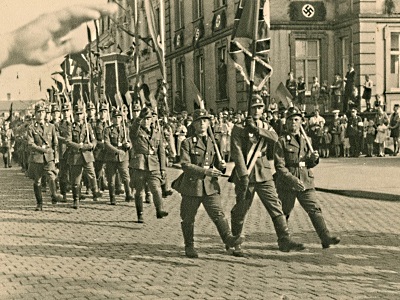Image: Bruderhof resistance to the Nazi regime led to three of its members being imprisoned – Hannes Boller, Karl Keiderling, and Hans Meier. In the photo, they have just been released and are safe in England with their wives and community.
Contemporary interest in modern German church history remains predominantly focussed on the Nazi period, and rightly so. Questions of responsibility and repentance or history repeating itself continue to confront those who look into this era. Similar themes arise in Imanuel Baumann’s book Loyalitätsfragen: Glaubensgemeinschaften der täuferischen Tradition in den staatlichen Neugründungsphasen des 20. Jahrhunderts (V&R Unipress, 2021). (The book has not been translated into English. The title translates as “Questions of Loyalty: Faith Communities in the Anabaptist Tradition during the State Reestablishment Phases of the Twentieth Century.”)
Here we learn of the attitudes of Mennonites, Baptists, and the Bruderhof toward the state during the beginning years of the Weimar Republic (1918–1933), Nazi Germany (1933–1945), and postwar East and West Germany. Notably, despite three different sections, more than half the book is set aside for the Nazi period. A Baptist himself, Baumann continues in the tradition of Christian groups reckoning with their past under Nazism. But it is by no means an apologetic work, and it makes for sobering reading. As the author himself discovered in the course of his research, “the free churches were not in quasi-natural opposition to the state but, on the contrary, had in part been extremely loyal to the state” (22).
First, Baumann attends to these groups in the Weimar Republic, the constitutional democracy that arose following the revolution that effectively brought an end to World War I – and the German monarchy. For republicans of the modern world, the significance of the monarchy can be difficult to fathom. But for many Christians at the time, its dissolution was mourned deeply. “What the royal family meant for the country and for us Mennonites in particular has not been extinguished by the most recent events, nor has it been erased from our hearts,” declared one Mennonite leader (46).
This was certainly a contributing factor in the suspicion (or even hostility) that Baptist and Mennonite leaders typically held toward any political platform left of center. As one figure put it, “A true Christian can never be a Social Democrat at the same time” (52). The Social Democrats were the majority party and staunch republicans. In addition to this, their wartime pronouncements against Christianity and the churches, although since softened, had not been forgotten by the free churches. Needless to say, the much more radical anti-monarchical and anti-religious commitments of the different communist parties were received with even less enthusiasm.
But, especially among the Baptists, Baumann finds evidence of political diversity. He also invites us to infer revolution-sympathetic pockets in some Baptist congregations, suggested by the strong words various leaders directed against related activities, presumably in their own congregations. In a less insurgent vein, though still significant, a leading Baptist magazine expressed a cautious optimism for the new democracy, comparing it to the internal government of the Baptist churches. Moreover, Baptists and Mennonites recognized that the new secular state could afford them a greater degree of equality before the law than they had been able to achieve in earlier times. By 1930, both groups had attained a legal status equivalent to that of the majority churches.
These positive views and interactions recede again, however, in Baumann’s summary. With regard to the Weimar establishment, Baptists and Mennonites “did not fight or boycott it but rather accepted it as inevitable for the time being” (112). The important term “loyalty” arises much more frequently in the context of the monarchy and, later, Nazi Germany.
At this point in the study, Eberhard Arnold and the nascent Bruderhof enter the scene. Throughout the book, their beliefs and actions regularly contrast – sometimes sharply – with those of their Baptist and Mennonite peers. For example, although heavily critical of the violence of those seeking revolution – social democrats, communists, anarchists, etc. – Arnold actually “saw specifically Christian goals or purposes represented in their demands” (60). Notably, he was also critical of Christians who could not recognise people’s material needs alongside their spiritual ones, a criticism that was similar to secular criticisms of Christianity from the left.
But Arnold was no secular critic. The summit of his socially oriented theology was his expectation of the kingdom of God. In contrast to human calls for revolution, this kingdom would be a true “world revolution.” Its revolutionaries would be men and women filled with the Holy Spirit, and it would be Jesus who was working through them to bring about justice and peace without recourse to violence. In more concrete terms, Arnold envisioned the overturning of the capitalist order through the establishment of a network of communities that shared all their possessions in common as the first Christians did. This hope was fundamental in the foundation of the collective at Sannerz, the first Bruderhof, in 1920.
In January 1933, Hitler was appointed chancellor of Germany. In the following months, civil rights were curtailed and political opposition quashed as the Nazi Party consolidated its power. This new era, marking the end of the Weimar Republic, is the subject of the second part of Baumann’s book.
Using the example of Baptist pastor Paul Schmidt, Baumann details the somewhat complicated reception of the new government by Baptists. Alluding to the Nazi seizure of power as a revolutionary act, for example, a view held by other observers at the time, Schmidt nonetheless cautioned that Christians themselves could not take part in any revolution, “neither to the left nor the right” (124). And a further note of caution can be detected in Schmidt’s statement that the government should not interfere with the church’s ability to gather or preach. Otherwise, Christians should show their loyalty toward the new administration and “recognize God’s order in the life of the state” (126).
But the relatively mild nature of Schmidt’s cautions is thrown into sharp relief by Baumann’s observation that the pastor only spoke about the limitations of Christian loyalty with reference to ecclesial matters. There was no talk of being disloyal to an administration that would oversee “the destruction of the constitutional state or the persecution of opponents of the regime and Jews” (127). While Baptist voices that were overtly critical of the Nazi Party are touched on in the notes, Baumann paints a picture of a denomination that, like the majority of other Christians at the time, was not deeply concerned with the direction the new state was heading.
Neither were Mennonites overly critical of the Nazi seizure of power, even if they too understood it in terms of the previously maligned word “revolution.” Indeed, one Mennonite publication from May 1934 looked back on the rise of the Nazis in the previous year with a quote from Psalm 118:23: “This is the Lord’s doing; it is marvellous in our eyes” (128). Notably, Baptists and Mennonites did not see the revolution to the left in 1918/19 to be of the same divine-historical significance as this revolution to the right. For them, the Nazis of the early thirties were Christian – or, at the very least, representative of Christian values – and the Weimar democracy was anti-Christian and morally permissive.
Baptists and Mennonites were especially impressed by the new government’s “purification of ‘moral’ conditions” (135), and some found merit in Nazi views on race and the nations, which apparently accorded with the order God had established for creation. For Mennonites especially, though, the chief selling point appeared to be the party’s thoroughgoing anti-Bolshevism – opposition to communism, particularly the influence coming from Russia and Eastern Europe. Already during the Weimar period, they had paid close attention to the treatment of their brethren in Soviet territories: after Russia’s October Revolution, Mennonite communities had been ravaged by Bolshevik-aligned soldiers (136). Later labelled “Kulaks” under Stalin, many families were torn apart, and members were sent to the gulag.
As such, a lot of Mennonites welcomed the Nazi imprisonment of communists and even social democrats as a necessary measure to protect the country from the reaches of Bolshevism. Some Mennonites even viewed Hitler as their “savior” (Retter, 139) in this connection. Others saw him as gift from God and divinely appointed for a special historical task, a view shared by many Baptists.
For us modern readers, who have the benefit of hindsight, the Bruderhof appears as a very welcome anomaly here. Baumann provides some key examples. On January 30, 1933, co-founder Emmy Arnold wrote to her sons, “Now the crisis has come to pass, and Hitler has been made Reich chancellor” (153). In March, member Annemarie Wächter expressed the community’s new sense of calling (and perhaps alienation) with regard to the new government when she spoke of being part of “an embassy in a foreign land” (153). And in May, Eberhard Arnold condemned the state’s “tyrannical despotism” and its “hideous arrogance, the filthiest kind of politics.” No one could “depend on any law anymore” (154).
The Bruderhof was appalled at the Nazi Party’s extrajudicial activity and the establishment of concentration camps for political opponents. The most fascinating aspect of their view of the state at this time, however, is its religious dimension. That “such a great horde of people can give their entire wills for a satanic power” was how member Arno Martin described it (154). And Eberhard Arnold found Revelation 13 adequate to the task of depicting Hitler’s government, a multi-headed monstrosity that receives its power from the dragon, Satan. The swastika resembled the mark of the beast, and the Hitler salute recalled the Roman imperial cults that the early Christians refused to partake in.
Nonetheless, the community did not stand in absolute opposition to the Third Reich. Following Romans 13, Eberhard Arnold held that, despite their demonic corruption, God instituted the governments of the world in order to punish evil. Faithful Christians should acknowledge this with their actions, demonstrating harmony with and loyalty toward the state. The Bruderhof leader even sought to identify positive features of Nazism: “Elements of family life, of protection against evil, of protecting what is good and right. They are the elements of national community and cohesion” (155).
Baumann urges careful reading on these points, however. The authorities in Romans 13, for example, are to discipline evildoers. They themselves are subject to God’s judgment wherever this boundary is violated. And with regard to Christian loyalty to the state, the Bruderhof found limits in various areas. Their rejection of Nazi-sponsored schooling and compulsory military service are two of the most noteworthy. Moreover, reflecting on Eberhard Arnold’s positive assessment of Nazi values, Baumann suggests that the community leader “was not placing value on Nazism’s concrete political notions but rather its ideals” (155).
The story of the Bruderhof under Nazism is a fascinating one, especially in view of the direction taken by the majority of Christians in Germany at the time. It ends with the community’s exodus to Liechtenstein and then England, after continued harassment from the authorities and a series of raids. No member was executed or sent to a concentration camp, though three did spend time in prison.
What should we make of this discrepancy between the Bruderhof and other Christian groups? Baumann certainly does not have much, if anything, to fault the community for when it comes to the Nazi period. First, the obvious should be stated. The group certainly stands out from the majority, but they were not alone in this. Baumann briefly draws our attention to the Jehovah’s Witnesses, for example, many of whom “were abducted into concentration camps, tortured, and died of various causes” (295). And his discussion of Baptists and military service is effectively a tribute to the little-known Alfred Herbst, a standout figure in a denomination not generally associated with conscientious objection. In 1943, the military court found Herbst guilty of dereliction of duty, having refused to take up arms. He was sentenced to death and left behind a wife and daughter.
Was it simply that the Bruderhof constituted a relatively small group, what is now called a “new religious movement” – a sociological phenomenon particularly prone to nonconformity, especially in its first generation? It certainly appears safer than a theological claim, though the two systems of classification need not be contradictory. If we say there are clear signs of God’s work in the Bruderhof during this period, was he not active in other churches as well, not to mention his apparent neglect of Nazism’s primary victims, the Jews? And if we venture to claim that God was indeed at work everywhere and all the time, continually calling everyone to repentance and obedience, then we should say it softly enough to still hear the objections.
Baumann’s study is finally an exercise in humility. It asks author and reader alike to see themselves as part of the many who welcomed the Nazi “revolution,” who saw in Hitler the guarantor of Christian values, who raised an unquestioning arm in salute. This humility is perpetually necessary if we are to confront the challenges of our own times, acknowledging that we will have weaknesses and blind spots unknown to us but pushing on as faithful ambassadors of an entirely different world.


